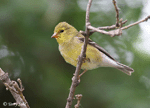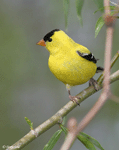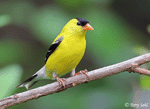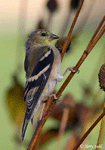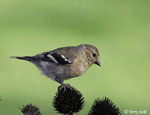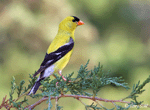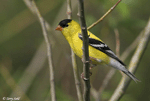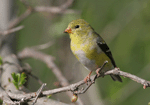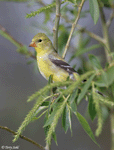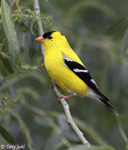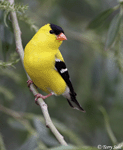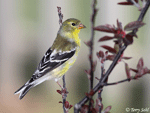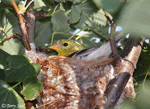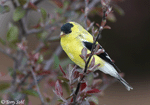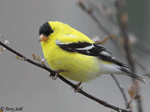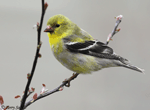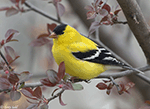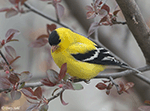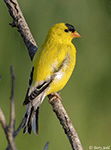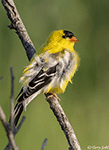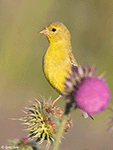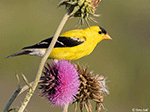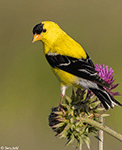| Length: 5 inches | Wingspan: 9 inches | Seasonality: Summer / All Seasons |
| ID Keys: Summer male distinctive, with black tail, wings and forehead on yellow body. More muted colors in winter. | ||
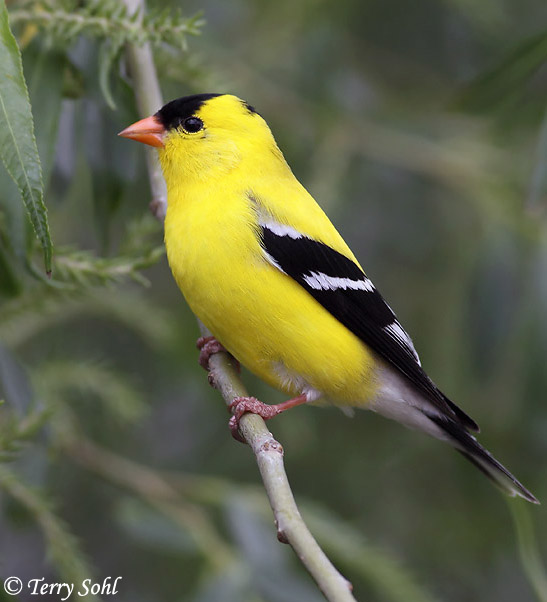 American
Goldfinches are a common sight at residential bird feeders in the United States,
and are well known for their "per-chickory" calls. They are the only finch
species that molt their feathers twice in a year. Males begin molting to their
bright yellow breeding plumage in early spring, and even the females become
brighter and more colorful for the summer breeding season. Both males and
females are much less colorful during the winter months. American
Goldfinch are also unusual in that they nest very late compared to most migratory songbirds, typically not starting to nest until mid-summer.
The delay in summer nesting is thought to coincide with availability of seeds on
which American Goldfinch depend, particularly milkweed and thistle.
American
Goldfinches are a common sight at residential bird feeders in the United States,
and are well known for their "per-chickory" calls. They are the only finch
species that molt their feathers twice in a year. Males begin molting to their
bright yellow breeding plumage in early spring, and even the females become
brighter and more colorful for the summer breeding season. Both males and
females are much less colorful during the winter months. American
Goldfinch are also unusual in that they nest very late compared to most migratory songbirds, typically not starting to nest until mid-summer.
The delay in summer nesting is thought to coincide with availability of seeds on
which American Goldfinch depend, particularly milkweed and thistle.
Habitat:
Roadsides, residential areas, brushy fields, forest edges, and orchards. In general, they like shrubby and weedy areas with plenty of seeds for eating, but with some trees or shrubs for nesting.
Diet:
Mostly seeds. Also buds, sap, and only on extremely rare situations, insects.
Behavior:
Often forages in small flocks, clambering and climbing over vegetation and seed heads. During the start of the breeding season, males can be seen giving a flight display, singing while they fly.
Nesting:
July and August. The nest of an American Goldfinch is a small cup built of grasses and other plant fibers, spider webs, and downy material from thistles and other plants. The female lays between 3 and 7 eggs, and she alone incubates them. When the eggs hatch, both parents help to feed the young. The young leave the nest after about 2 weeks.
Interactive eBird Map:
Click to access an interactive eBird map of American Goldfinch sightings
Song:
The song of an American Goldfinch is a variable jumble of warbles and trill notes.
- Click here to hear a singing male American Goldfinch, recorded in Pope County, Minnesota1
- Click here to hear a typical call of an American Goldfinch, recorded in Moffat County, Colorado2
Migration:
Irregular resident in the winter, with large numbers staying one year and very few the next. In our yard in Brandon, South Dakota, we do typically have some around all year long.
Similar Species:
Lesser Goldfinch, Lawrence's Goldfinch. Plumage and bill differences make it possible to easily distinguish between the species. In breeding plumage, American Goldfinches are the only goldfinch species with an orange bill. Females are generally more difficult to differentiate for the three species, but the white undertail coverts of a female contrast with the yellow of a Lesser Goldfinch, while the Lawrence's Goldfinch has yellow wing bars instead of the white on an American and Lesser Goldfinch. Click here for a page that describes the differences between American, Lesser, and Lawrence's Goldfinch.
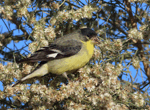 |
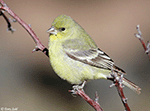 |
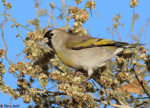 |
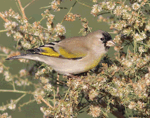 |
| Lesser Goldfinch (male) | Lesser Goldfinch (female) | Lawrence's Goldfinch (male) | Lawrence's Goldfinch (male) |
Conservation Status:
Widespread and common, with local fluctuations in populations but no widespread trend. American Goldfinch are found across a very broad geographic area, and are common on many parts of that range. The IUCN lists the American Goldfinch as a species of "Least Concern".
Bird Feeders:
Will attend feeders for thistle (niger) and sunflower seeds.
Further Information:
Photo Information:
April 23rd, 2004 -- Brandon, South Dakota -- Terry L. Sohl
Additional Photos:
Click on the image chips or text links below for additional, higher-resolution American Goldfinch photos.
Audio File Credits:
- 1Jonathon Jongsma, XC428425. Accessible at www.xeno-canto.org/428425
- 2Andrew Spencer, XC109300. Accessible at www.xeno-canto.org/109300
| Click on the map below for a higher resolution view |
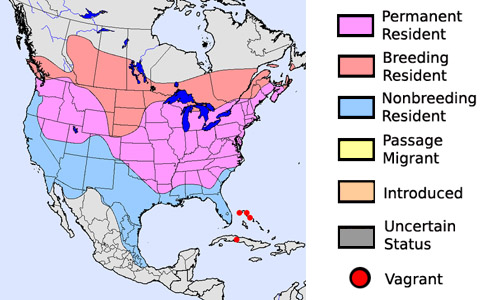 |
| South Dakota Status: Common summer resident and migrant statewide. Common winter resident in the south, much less common in the northern part of the state. |
Additional American Goldfinch Photos
Click for a higher-resolution version of these photos
